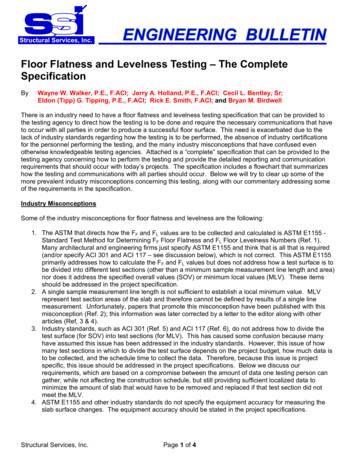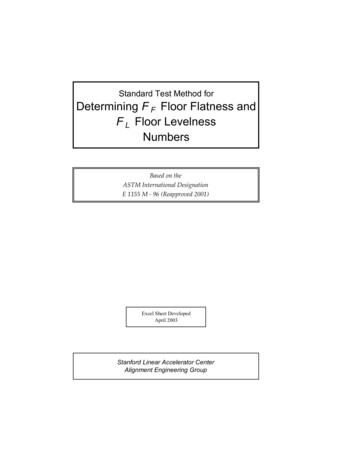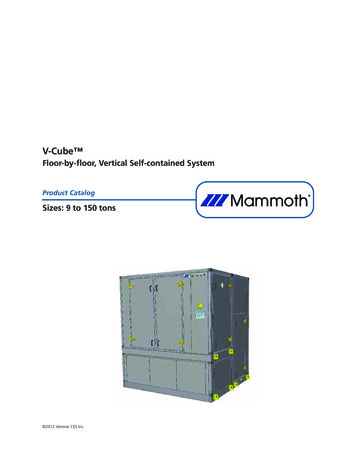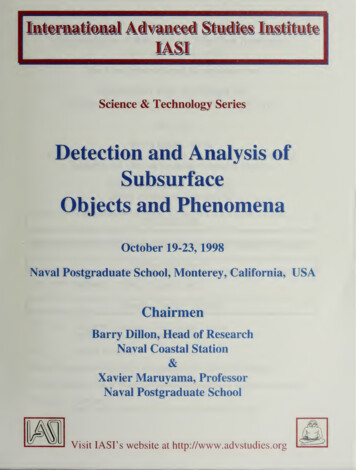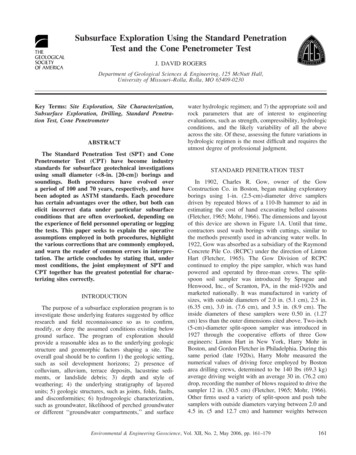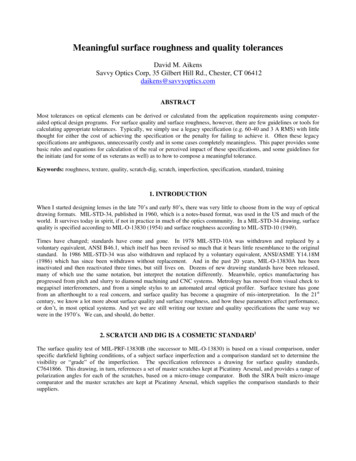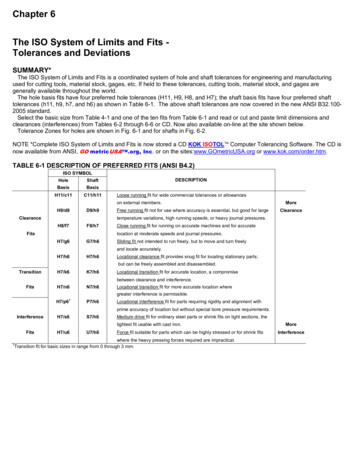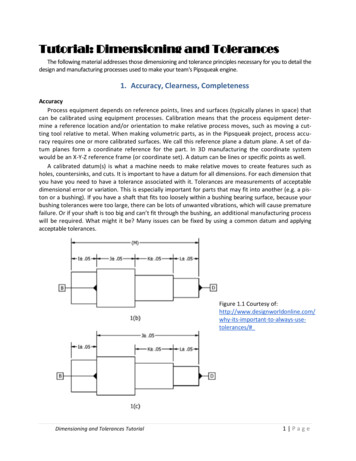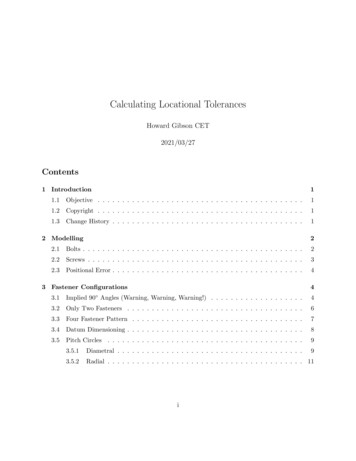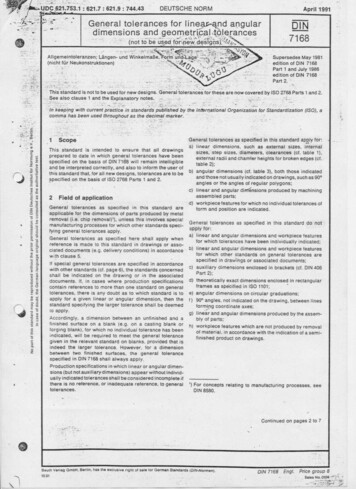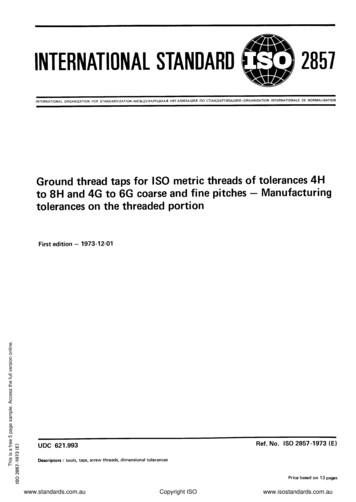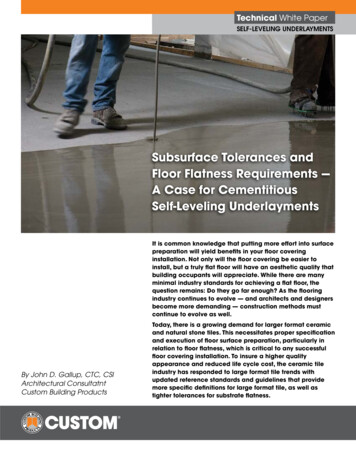
Transcription
Technical White PaperSELF-LEVELING UNDERLAYMENTSSubsurface Tolerances andFloor Flatness Requirements —A Case for CementitiousSelf-Leveling UnderlaymentsIt is common knowledge that putting more effort into surfacepreparation will yield benefits in your floor coveringinstallation. Not only will the floor covering be easier toinstall, but a truly flat floor will have an aesthetic quality thatbuilding occupants will appreciate. While there are manyminimal industry standards for achieving a flat floor, thequestion remains: Do they go far enough? As the flooringindustry continues to evolve — and architects and designersbecome more demanding — construction methods mustcontinue to evolve as well.By John D. Gallup, CTC, CSIArchitectural ConsultatntCustom Building ProductsToday, there is a growing demand for larger format ceramicand natural stone tiles. This necessitates proper specificationand execution of floor surface preparation, particularly inrelation to floor flatness, which is critical to any successfulfloor covering installation. To insure a higher qualityappearance and reduced life cycle cost, the ceramic tileindustry has responded to large format tile trends withupdated reference standards and guidelines that providemore specific definitions for large format tile, as well astighter tolerances for substrate flatness.
Technical White PaperSELF-LEVELING UNDERLAYMENTSAt Custom Building Products, we believe substrate flatness is best achieved through theapplication of a flowable and cementitious self-leveling underlayment (SLU) and wehave developed this paper to address: Potential conditions in the floor subsurface and the industry’s requirementsrelated to them Proper specification and installation of a self-leveling underlayment over somecommon flooring conditions and substrate types The benefits of specifying self-leveling underlayment and cement-based patchingand leveling compounds for all hard surface and resilient flooring products The performance and cost efficiencies inherent in using self-levelingunderlayment materialsEnhanced Definitions for Large Format Tile and SubsurfaceFlatness RequirementsThe American National Standards Institute (ANSI) Specification for the Installation ofCeramic Tile stipulates that deviations in sub-floor flatness should be no greater than1/4" in 10' (Ref. ANSI A108.02 – 4.0 / 4.1.4.3.1). Before the year 2010, the TileCouncil of North America (TCNA) described large format tile units as “ generallyconsidered to be 8" x 8" and greater”, with no provision for enhanced subsurfacetolerances when tiles 8" x 8" or larger had been selected. However, as of 2011,subsurface tolerances for tile installation, based on tile unit size, have been updated inthe TCNA Handbook. For tiles with all edges less than 15", the maximum allowablevariation is 1/4" in 10' and no more than 1/16" in 12". For large format tiles with oneedge greater than 15" and for natural stone tiles, the maximum allowable substratevariation can be no more the 1/8" in 10' and 1/16" in 24". When thin bed epoxymortars are used, the variation can be no more than 1/16" in 36" with no abruptirregularities greater than 1/32" (2011 TCNA Handbook). In some instances, thearchitect/designer will require the more stringent finish tolerance, and the subsurfacespecification or tile specification should reflect this.In response to the new subsurface flatness criteria, a number of tile manufacturersspecializing in large format tile materials have embraced these updated floor flatnessrequirements, and now include references to the new guidelines in their product technicaldata sheets and installation guidelines. It is the responsibility of the architect or designprofessional to include these enhanced floor flatness requirements in the projectspecification. It is equally important for the architect or specifications writer to consult withthe design/interiors team (and vice versa) to insure that the specific installation requirementsand guidelines for the selected tile for the project are reflected in the tiling specification.To achieve the required flatness tolerances, the industry is increasingly relying on selfleveling underlayments. By virtue of the SLU’s working characteristics and performance,a flowable, cementitious self-leveling underlayment will provide flatness tolerances wellwithin 1/8" in 10' maximum plane variation. This provides a finished substrate that canaccept most ceramic and natural stone tile, including tile that maintains any edge of 15"or greater, as well as all types of resilient flooring.Traditional Straightedge Specification vs. F-Numbersfor Rating Floor FlatnessThe American Concrete Institute (ACI) has adopted the so-called “f-number” system, underthe ACI 117 specification, as a way of determining the flatness (and levelness as per F/Lnumbers) of concrete slabs. F-numbers are determined through testing procedures inASTM E-1155. These testing procedures are also referenced in ASTM F-710 for ThePreparation of Concrete Floors to Receive Resilient Flooring. Determining the flatness of aconcrete slab using the ASTM E-1155 method provides more accurate and reliable resultscompared to the conventional “straightedge specification” for 1/4" in 10', and 1/8" in 10'plane variation. Under ASTM E-1155, ACI sets forth guidelines that require specified floorflatness be assessed within 72 hours after concrete installation, to insure accuracy.Photo Courtesy ABW Construction – Woodinville, WA
Technical White PaperSELF-LEVELING UNDERLAYMENTSWhere a typical straightedge method for plane variation indicates only where gaps occurbetween a 10' straightedge and finished floor, floor flatness testing procedures underASTM E-1155 provide a more quantitative method for determining the flatness andlevelness of the entire concrete substrate. While a number of various techniques exist formeasuring concrete to determine f-numbers, perhaps the most common is the “dipstickfloor profiler” method, in which assessments are taken at a frequency of 1 ft., in bothnorth/south and east/west directions. Measurement lines must maintain a minimum of11 ft., and a minimum of 34 readings per 1000 sq. ft. of floor is required. The“dipstick” testing apparatus is broadcast along a line, which measures the variation insurface elevation at 1 ft. intervals. A reading is recorded at a point when the dipstick ispivoted, and the alternate “foot” of the apparatus is placed on the slab.Photo Courtesy ABW Construction – Woodinville, WAProject Specifications Shall Indicate the Corrective Measuresfor Concrete Slabs that are not in Compliance with Projectand Condition Requirements.Appropriate floor flatness requirements for the slab, based on conditions, intendedusage, and service requirements, can be found in ACI 302 section - Guide for ConcreteFloor and Slab Construction. Although there is no exact method of comparing f-numbersto conventional straightedge testing results, the following chart can be used as aguideline to approximate values between the two:F-Number Result (FF)Straightedge Specification Result(Plane Variation in 10')251/4"501/8"1001/16"F-Number Results of Self-Leveling ApplicationsInstalling a self-leveling underlayment makes it easy to exceed the requirements of thefloor covering. Using the testing procedures outlined in ASTM E-1155, floor surfacescovered with a cementitious SLU have rendered f-numbers in the mid to upper 80’s. Thefollowing is one example of field test results for a floor covered with CUSTOM’s highperformance SLU:Minimum Required Flatness/Levelness30 Day Result using SLU35 / 2586.6 / 46.2Lippage, Facial Variation of Tile Units and CraftsmanshipLippage is an unsightly and potentially hazardous defect in a ceramic and natural stone tileinstallation. It is a condition in which one edge of a tile is higher than the adjacent tile,which gives the finished surface an uneven appearance. When tile is selected as a flooringfinish, accessibility is a key consideration, and design professionals should understand thatany plane variation in the subsurface would be reflected in the finished installation. In short,a true and flat subsurface, within the flatness tolerances set forth in ANSI sections A108.01and A108.02, will only minimize lippage conditions and any potential subsequent liabilityissues caused by unexpected changes in the plane of the finished floor.Facial variation of the tile units that are being considered for the installation will alsopresent some challenges. A tile installation with tile units maintaining any facial variationwill be made even more challenging over a subsurface that maintains a change of planeoutside of the ANSI and TCNA flatness guidelines. ANSI A108.02 – Section 4.3.8stipulates that the grout joint width shall be at least three times the actual facial variationof the tile. Proper surface preparation with regard to subsurface flatness tolerances willallow for a much more efficient and less challenging tile installation, particularly whenyou are dealing with non-rectified tile units which maintain a facial variation, as describedin ANSI A108.02 4.3.8. It is important to note that thin-set bond coats are intended solelyto bond the tile to the substrate. They are not formulated for use as leveling agents.
Technical White PaperSELF-LEVELING UNDERLAYMENTSWood and Resilient Flooring Also Need Flat UnderlaymentsJust like ceramic tile, wood and resilient flooring require a high degree of flatness thatcan easily be achieved using a cementitious SLU. Many manufacturers of wood flooringrequire that the variation in floor flatness be no more than 3/16" in 10' and 1/8" in 6'.The installation of wood flooring also requires that the floor be dry. Because of the rapidcuring of cementitious SLU, it is possible to achieve a dry floor that meets the industryrequirements in less than 24 hours. Many of the adhesives used to bond wood andresilient flooring are sensitive to moisture and extreme pH readings, CUSTOM’s SLU isformulated to balance the finished pH to accommodate most common adhesives.Condition Requirements Prior to Application ofSelf-Leveling UnderlaymentIt is typically recommended that SLU be applied in conditions where ambienttemperature is above 50 F, and not more than 90 F. To ensure the integrity of theprimer, the moisture vapor transmissions rate (MVTR) from the substrate should not bein excess of 5 lbs. of water/day/1000 sq. ft., based on a standard ASTM F-1869(Calcium Chloride) test, or 80% rh, based on ASTM F-2170. A moisture content that istoo high will also slow the cure of the SLU and can affect the subsequent floor finish.Most floor covering manufacturers will have acceptable limits for MVTR and theirrecommendations must be followed. Consult with Custom’s technical representatives forspecific recommendations regarding CUSTOM’s SLU and your particular installation.Definition, Formulation, and Performance Values ofSelf-Leveling UnderlaymentSelf-leveling underlayment (SLU) for flooring consists of a blend of Portland and/orcalcium aluminate cements, inorganic aggregates, co-polymers, and chemicalmodifiers, which form a flowable, self-leveling compound for leveling interior subfloors.These components form a high compressive strength and flowable cementitiouscompound, resulting in a flat-level surface that accepts all ceramic and natural stone tilefloor finishes. Many SLU manufacturers state that select self-leveling materials alsoprovide proper surface prep and acceptability under alternative floor finishes, such ascarpet, vinyl, linoleum, resilient, and hardwood flooring. Refer to the manufacturers’published data sheets for compatibility with alternative floor finishes. Virtually all thecementitious SLU sold today is mixed with water only; no liquid acrylic-latex additive isrequired. The dry re-dispersible co-polymers in the manufacturer’s formulas provideimproved bond strength and flexibility. SLU is formulated with proprietary copolymers andcements, which provide ultra high compressive values, in some materials in excess of4000 psi. The high compressive value of SLU materials results in a floor assembly thatconsistently passes all 14 cycles on an ASTM C627 Robinson Floor Test for mostapplications. This ‘Extra Heavy Duty’ rating for the finished floor is crucial for floors thatare subject to heavy foot traffic and large equipment such as scissor lifts and palletjacks. Alternative self-leveling applications, such as those over hydronic tubing or electricradiant heat systems, will provide a moderate service rating. Installations over wood joist/ plywood subfloor installations can provide anywhere from a light commercial to astandard residential service rating, depending on the specific assembly detail.The versatility of cement based self-levelers allows for SLU pours that can be appliedfrom 1/8", all the way up to 1 1/2", or in some cases, up to 2" in total thickness. SLUmaterials can also be feather-edged to transition to other floor finishes. Allowablethicknesses will vary depending upon the manufacturer and the specific formula. Certainproprietary formulas are available that provide an extended set for pumping. These aredesigned for use in high ambient temperature conditions, or over large spans whenmore time to float the material is required.Cure rates of SLU materials provide for a fast setting underlayment that can acceptceramic or natural stone tile set with modified thin set in as little as 4 hours and 12 to14 hours for resilient flooring after the SLU is poured in place. This helps to minimizeproject downtime and allows the work schedule to proceed more expeditiously.
Technical White PaperSELF-LEVELING UNDERLAYMENTSDetails and Guidelines for Self-Leveling UnderlaymentsDetails and installation guidelines for floor systems that include an SLU are outlined inthe Tile Council of North America Handbook for Ceramic, Glass, and Stone TileInstallation. The handbook recommends crack-isolation membranes, such asRedGard , Cu
AStM e-1155 provide a more quantitative method for determining the flatness and levelness of the entire concrete substrate. While a number of various techniques exist for measuring concrete to determine f-numbers, perhaps the most common is the “dipstick floor profiler” method, in which assessments are taken at a frequency of 1 ft., in both
